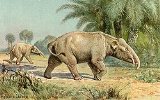
Palaeomastodon
Encyclopedia
Palaeomastodon an extinct genus of Proboscidea
. Palaeomastodon fossils have been found in Africa, lived some 36-35 million years ago. They are believed to be the ancestors of elephants or mastodon
s. This genus is related to Moeritherium
.
 Palaeomastodon had tusks, both upper and lower. It had a trunk. It was 1 to 2 meters tall and weighed up to 2 tonnes. The lower tusks were flat rather than pointed cones, and were probably used to scoop plants from swampy water.
Palaeomastodon had tusks, both upper and lower. It had a trunk. It was 1 to 2 meters tall and weighed up to 2 tonnes. The lower tusks were flat rather than pointed cones, and were probably used to scoop plants from swampy water.
Paleomastodon, http://www.elephant.se/palaeomastodon.php?open=Extinct%20Proboscidea
Proboscidea
Proboscidea is a taxonomic order containing one living family, Elephantidae, and several extinct families. This order was first described by J. Illiger in 1881 and encompasses the trunked mammals...
. Palaeomastodon fossils have been found in Africa, lived some 36-35 million years ago. They are believed to be the ancestors of elephants or mastodon
Mastodon
Mastodons were large tusked mammal species of the extinct genus Mammut which inhabited Asia, Africa, Europe, North America and Central America from the Oligocene through Pleistocene, 33.9 mya to 11,000 years ago. The American mastodon is the most recent and best known species of the group...
s. This genus is related to Moeritherium
Moeritherium
Moeritherium is a genus consisting of several species. These prehistoric mammals are related to the elephant and, more distantly, the sea cow...
.

Sources
- Chased By Sea Monsters by Nigel Marven and Jasper James (Pg.128)
Paleomastodon, http://www.elephant.se/palaeomastodon.php?open=Extinct%20Proboscidea

